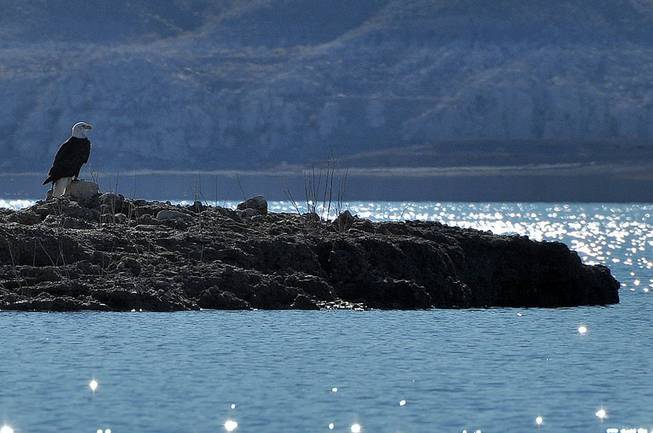
Lake Mead National Recreation Area Photo
Volunteers and biologists spotted 132 bald eagles at Lake Mead National Recreation Area Jan. 15 during an annual eagle survey. Bald eagles migrate from the north and can traditionally be spotted at Lake Mead NRA from late-November to March.
Monday, Jan. 27, 2014 | 5:17 p.m.
About 132 bald eagles have made the Lake Mead National Recreation Area their winter home this year.
That figure is the result of an annual survey conducted by volunteers and biologists who spent Jan. 15 on boats ln Lake Mead and Lake Mohave, surveying the shoreline with binoculars to spot the raptor species. The National Park Service, Nevada Department of Wildlife, U.S. Fish and Wildlife Services and U.S. Bureau of Reclamation participated in the midwinter survey, officials said.
Although this year’s count is slightly lower than last year’s total of 161 bald eagles, biologists weren’t surprised by the outcome. This year’s count is also the fifth-highest the team has had since it began doing the surveys in 1995.
“I expected the number to be down somewhat this year due to the mild winter we are experiencing in the West,” park biologist Ross Haley said in a news release. He said the total was “possibly exacerbated somewhat by the West Nile virus die-off.”
Late last year, there was a die-off of bald eagles near Salt Lake City after an outbreak of the West Nile virus. According to officials, the birds likely contracted the disease from eating infected eared grebes.
Surveyors also recorded seeing 19 red-tailed hawks, 16 peregrine falcons, nine northern harriers, one prairie falcon, one osprey, one American kestrel and three unidentified raptors. The team began its survey of the 1.5 million-acre recreation area shortly before sunrise and finished at sunset.
The bald eagles, which migrate here from late November to March, could be seen perched on rocky cliffs, sipping water or soaring over the lake, officials said.
The bald eagle has appeared several times on endangered species lists because of habitat destruction, illegal shooting and contamination of its food sources. A 1972 ban on the pesticide DDT paved the way for the species’ recovery. In June 2007, the bald eagle was removed from the endangered and threatened species list, but it still remains protected under the original Bald and Golden Eagle Protection Act and Migratory Bird Treaty Act.


Join the Discussion:
Check this out for a full explanation of our conversion to the LiveFyre commenting system and instructions on how to sign up for an account.
Full comments policy